If you want on time success, use our mb2-631 book exam product and exam 70-400 study guide. You can also use our superb exam pass resources like exam 70-541 braindumps along with 70-557 audio exam and HP2-Z15 dumps.

©James Bowles Editor's Note:See updated discovery April 2006 at bottom of page! PROLOGUE
A chance overflight of the Cordilleras range in Central Peru in the years prior to WW-II [2] was the event leading to the re-discovery of the line figures on the plateau, the Pampa Jumana-Colorada,
above Nazca where for centuries these pastoral images that speak in silent voice to a lost legacy of the past, lay hidden. Unremarkable on their own, except for their intricacies, their immense size, and the
apparent reference to life through the belabored display of the genitals, but yet compelling, these graphic patterns were thought by some investigators to be religious or astronomical exhibits from a long lost
generation. We are to learn different!
In his book, Beyond Stonehenge, Gerald S. Hawkins describes the unchanging scene of the Peruvian mesa:
Robert Bauval and Adrian Gilbert, co-authors of, The Orion Mystery,[7] give a detailed accounting of the discovery.
These primal Texts are Creation stories. They are about Atum Rá, the primeval god who evolved from the Chaos, and of Thoth, the ithyphallic monkey, [10] they are about Seth, the brother of Osiris
who in a fight with Horus lost his testicles, and of Horus, the allegorical son of Osiris, who lost his eye in the conflict with Seth ... and each story, as we'll see in a moment, is illustrated on the
Peruvian mesa.
The story of Atum Rá opens with the creation of the Ennead.
Atum Rá is sculpted in ghostly ithyphallic form on a rocky projection with his back at about 60 degrees, in this sense he is Erect, and consistent with his orgasmic form of creation. His feet are not
shoe-like, but more like testicles. The lines that make up the contours of his body .. are like veins. He is portrayed as an erect penis, and he is shown pregnant! His right arm is raised as if to acknowledge a
higher Being, and to demonstrate the physical capacity to accomplish the creative act!
The Pyramid Texts are not alone in conveying the message of the Nascan graphic narratives, for in a more modern time and in another style, the ballad of The Phoenix Bird, by Hans Christian Andersen, [11]
captures the same essence!
(born) "In the Garden of Paradise, beneath the Tree of Knowledge, His flight was like the flashing of light, his plumage was beauteous, and his song ravishing. He wings his way in the glimmer of the
Northern Lights over the plains of Lapland, and hops among the yellow flowers in the short Greenland summer ... The Phoenix Bird, dost thou not know him? The Bird of Paradise, the holy swan of song
... On a lotus leaf he floats down the sacred waters of the Ganges, and the eye of the Hindoo maid gleams bright when she beholds him."
If the reader would compare the following phrases from Hans Christian Andersen's The Phoenix Bird, with the adjoining illustration of the Nascan figures it would become apparent to them that
these phrases originated from Nasca and the Texts. Our ignorance of these artifacts must be of VERY recent origin indeed!
a) the Garden of Paradise
b) the Tree of Knowledge
c) The Phoenix Bird
d) a lotus leaf
e) the eye of the Hindoo maid gleams (see (§ 976) below that reads in part, "The Eye of Horus gleams ."
The continuing story of the Peruvian plateau, as with the Texts of Saqqara, is one of creation, and it played out in the mystic period of the Alaskan Era. It played out the themes that later spawned the lore
and the legends of Raven, who as a creator called humans up from the earth or from clamshells, and it spawned the myths of the sometimes benevolent, sometimes malicious, sometimes spiritual, sometimes
corporeal Thunder Birds of the native tribes of the Americas.
Many thousands of years before the legends of the Thunder Birds another drama was being played out, this one on the lush arenas of the equator and it was to have a direct bearing on the events that would
reveal the nature of the treasures of the Ancients and it would spawn the drama told in modern myths. But in order to authenticate these relationships, we have to establish the geographics of the ancient times.
So let's visit the second player on the modern scene.
In 1958 Professor Charles H. Hapgood published a book titled, Earth's Shifting Crust. [12] (also see Changing Poles) In it, he put forward a theory that described how the Earth's outer crust could slip in tact across the inner mantle,
thereby creating all new geographics with respect to the equator and the geographical poles. Einstein, in the forward to this most remarkable book, agreed!
Hapgood explains that these catastrophic episodes visit the earth with shattering magnitude and in consequence little remains in the form of a cultural accounting. So for lack of other identities, he
characterizes each episode by the lands that occupy the northern polar position. His research identifies four events, or Eras, with the following lands occupying the polar position; starting with the most
ancient, they are Alaska, Greenland, Hudson Bay, and the Arctic Ocean (the current Pole).
We're interested in the period when Alaska occupied the pole position, because in this, the Alaskan Era of 30,000 years ago, Nasca (the site of the wondrously giant line figures) and Giza (the site
of the pyramids and the Sphinx) were both on the equator. So, as a matter of interest, was Easter Island.
Should we have been able to travel the meridional line south from Alaska to Nasca, hence along the path of the equator east to Giza, hence north to our place of beginning in Alaska, we would have been
following the course of the Sacred Terrestrial Triangle of the Ancients, the double of the Great Pyramid of Giza. For the base angles of this Sacred Terrestrial Triangle measure out at exactly those of the
Great Pyramid ... 51 degrees, 52 minutes.
One is the Double of the other .. their angular exactness establishing the relationship.
The illustrations that accompany this article are reproduced from photographs of the line figures above Nasca, Peru, and far from being mere "religious and astronomical" curiosities, they are the most
eloquent cultural artifacts in the world and are of extreme importance. For not only are they related in subject content, they are pre Old Testament Biblical, and they address the origins of man.
By example, let's look at the last few words of a very compelling passage, because they relate to that very ancient time in history before the Serpent in the Garden of Eden, and before it had been
determined that man would procreate in union.
Within the Texts are hundreds of stories that are illustrated into meaning by the graphics on the Nascan mesa. The best of these are the stories of Atum Rá, Thoth and the Ennead, and of Horus,
and they serve well in demonstrating the relationship between Nasca and Giza and their association with the Mystic period of the Alaskan Era.
Here is one of the most relevant passages in this story of creation from the Texts,
Atum Rá (the ithyphallic ghost of the Peruvian Plateau) was the most important of the pre-dynastic Egyptian Gods. But the most interesting aspect of the portrayal of Atum Rá in (§ 1655) is that he is
introduced TWICE. First he is a member of the Ennead, (namely) "Atum Rá, Shu, Tefénet, etc.,"
Then we find him in the same passage as the apparent Father
"O you children of Atum."
Atum Rá is apparently both Father (Atum) and Son (Atum Rá).
Recognizing now the two eyed ghost like appearance of the Nascan Atum Rá, it is not an unlikely stretch of the imagination to conclude that we're looking upon a Holy Triad, The Father,
(Atum) The Son, (Atum Rá) and the (Nascan) Holy Ghost. But the two eyes are most uncommon for an ithyphallic figure .. unless it is a hermaphrodite. As a hermaphrodite Atum Rá would be
capable of self fertilization, hence capable of fathering the Ennead, and this is perhaps why the Nascan image appears to be pregnant.
There is further significance in Atum Rá's two eyes, and it's going to be made clear when we go ringside in a fight between Seth and HORUS, a story which I'l relate
shortly, but we must meet THOTH before we can understand Horus.
Thoth is both male and female, he is Atum Rá's Ambassador, the incarnate bearer of the knowledge and mysticisms of the gods. He is represented on the plateau as a cynocephalus monkey,
or flying Lemur.
The part of his story that I will relate is told by his arms and hands, for instance, when we look at Thoth's hands in Figure 5., we see a most unusual feature. There are five fingers on the left hand but
only four on right. These nine fingers of Thoth's represent the nine gods of On:
Five male: Atum Rá, Shu, G'b, Seth, and Osiris
Four female: Tefénet, Nat, Isis, and Nephthys
The male gods are depicted by the lines that drop from the hindquarters and are of little interest as this is common phallic symbology, but the portrayal of the female gods is another matter, and it poses an
interesting challenge to one's imagination. Although in the final analysis the intent will be very clear, and it can't help but leave us with a tremendous appreciation for the Ancient wisdom.
The initial analysis develops from the recognition of the very distinctive feminine cradling aspect of the shoulders, arms and hands of Thoth. The story is told in Figure 4.
The furthering story of Horus is expressed in a multiple of ways, starting with Atum Rá ... from whom Shu and Tefénet were born .. then from Shu and Tefénet we have (though not in
this order) Seth, and Nephthys, and the first of the man-gods, Osiris and his sister-wife Isis. Seth later killed Osiris and spread his parts around the world. But Isis, wanting child by her husband Osiris,
gathered his parts that they might consort.
She was successful in finding and re-assembling all of his parts except for one .. his phallus, which later turns up on the plains of Nasca in the form of Atum Rá ... at this point we must realize that
Horus, as a consequence of the union of Isis and Osiris, could never have been.
Rather Horus lived metaphorically as the ethereal epitome of all that was noble, decent, virile and fruitful, and in combination with Hathor (who was simply Isis in gestation) was the symbol of the gift of
union between men and women in the act of procreation in the evolving story that was Creation.
THOTH and the EYE OF HORUS
The furthering story of Horus and Thoth evolves from the Peruvian figures and the Texts in an interesting manner. Observe in Figure 5., that two lines, one drawn through the arms of Thoth, converge at a
single point at Thoth's left. These lines symbolize a gradual transition from the hermaphroditic state of the gods, to a corporeal existence as men and women and the dependence on union in the act
of procreation, hence dependence on a male copulating member with "one eye!"
This graphical precept is expressed in the Texts as well.
The phrase ".. upon the wing of Thoth" in (§ 976), makes reference to the cynocephalus monkey, or flying Lemur. The Lemur "flies" by spreading its arms and legs to unfold a membrane that adjoins the
fore-arms and body, hence the term "wing," hence the phrase, " .. upon the wing of Thoth .. "
The Texts are not easy to read, and the stories told are extremely complex, but with the help of the Nascan figures we can render meaning where before there was none. For instance, there are a number of
passages that refer to the efflux (the seminal fluid) from the Eye of Horus. The Eye of Horus remember is the one removed from the ithyphallic hermaphrodite Atum Rá. The (single eyed) Atum RáRe
thus transformed into the first man god Osiris, leaving the god-spirit of Osiris as another entity with a totally different identity.
And here again we are witness, but this time from a slightly different take, to the Holy Triad, The Father, (Atum) The Son, (Atum Rá) ... but this time we see the origin of the (Nascan) Holy Ghost,
in the spirit of Osiris.
These are the passages that refer to Eye of Horus and its effluent water.
(§ 44) "O Osiris the King, I conduct you to your son Horus; put him within yourself."
The two appeals for Osiris to " .. take the water which is in the Eye of Horus .. and "..put him within yourself," has two meanings.
The first was an appeal by Isis for Osiris to take the seminal fluids that she might get pregnant by means of it.
The second was an appeal to take the seminal fluids that man would live thereafter depending upon union in the act of procreation.
On a related matter, the Horus-Eye analogy suggests an origin to a Dynastic period ceremonial custom. The custom being that in ceremony each of the Pharaoh-Kings of ancient Egypt was bestowed with
the deification of a Horus-King. This had to be for a very specific (though previously unknown) reason. Could it have been in reality a Ceremony to bestow the new Horus-Pharaoh-King with the gift of
fertility?
It would be a rare gift indeed, and totally consistent with the real Horus!
EPILOGUE
Of themselves, the Peruvian Graphics and the Egyptian Texts make little sense, but placed together on the same page, or in coincidental thought, they combine to remove the abstractions present in each of
them, and I think you'll agree, the stories told come alive!
But having now observed the inter-dependence of the Pyramid Texts and the Nascan Graphics, one upon the other in providing meaning, perhaps we should be taking the next step and ask why the
custodial charge for these two artifactual elements were geographically isolated and culturally separated from one another? Unless by our having asked we have stumbled upon the answer! Could it be that
the Terrestrial Triangle, within which Nasca and Giza are but two elements, is actually a Sacred Triad? Could it be that there is something yet to be found at the third point in Alaska?
Is there a missing element of this Triad to be found? I think so, and I'll let you know what it is, after I find it!
James Bowles, author, The Gods, Gemini, and the Great Pyramid
ENDNOTES
1.) Faulkner, R. O. The Ancient Egyptian Pyramid Texts, Aris & Phillips-Warminster-England, Oxford University Press, 1969
2.) Hawkins, Gerald S., Beyond Stonehenge, Harder & Row, Publishers, New York, London, 1973, Pg. 96
3.) Ibid., Hawkins, Pg. 149
4.) Ibid. Pg. 103
5.) Ibid.
6.) Ibid., Pg. 104
7.) Robert Bauval and Adrian Gilbert, The Orion Mystery, Crown Paperbacks, New York, 1994
8.) Ibid., Bauval/Gilbert Pg. 57-8
9.) Ibid., Faulkner, Preface, Pg. v
10.) My identification of the monkey on the "Stairway of the Gods of Nasca," as a cynocephalus monkey, or flying Lemur, rather than the common baboon reference is justified because the translations of
the Pyramid Texts, by Sethe, and later by R. O. Faulkner, were generic and without benefit of Nasca’s clarifying graphics.
11.) Hans Christian Andersen, 1805-756, was a Danish novelist and poet known for his fairy tails, "The Princesses and the Pea," "The Ugly Duckling," and the "Phoenix Bird," among others.
12.) Charles H. Hapgood, Earth's Shifting Crust, Pantheon Books, 1958
UPDATE APRIL 2006
Japanese researchers find new giant picture on Peru's Nazca Plateau
The new Nazca Plateau image discovered by the research team from Yamagata University. (Photo courtesy of Yamagata University)
The image is 65 meters long, and appears to be an animal with horns. It is thought to have been drawn as a symbol of hopes for good crops, but there are no similar patterns elsewhere, and the type of the animal remains unclear.
The discovery marks the first time since the 1980s that a picture other than a geometrical pattern has been found on the Nazca Plateau.
The picture was found by a team of researchers including Masato Sakai, an associate professor at Yamagata University, after they analyzed images from a U.S. commercial satellite. They confirmed it was a previously undiscovered picture in a local survey in March this year. It is located at the south of the Nazca Plateau, and apparently went undiscovered since few tourist planes pass over the area.
There is evidence that vehicles had driven in the area, and part of the picture is destroyed.
Two parts of the picture, that appear to be horns, bear close resemblance to those that appear on earthenware dating from 100 B.C. to A.D. 600, during the time when the Nazca kingdom flourished, and it is thought that they relate to fertility rites.
The research team will use images from the advanced land-observing satellite "Daichi," which was launched by the Japan Aerospace Exploration Agency in January this year, to create a distribution map of images on the earth that can be seen from the air.
"We want to identify all the images, and work to preserve earth pictures that are gradually being destroyed," Sakai said. (Mainichi)
|

Other history related articles on this site:
.
.
.
.
.
.
.
.
.
.
.
.
If you have a suggestion or history related article to submit, send it to:
Editor/viewzone.com
myristicin@hotmail.com
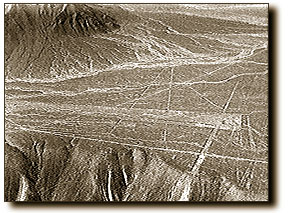
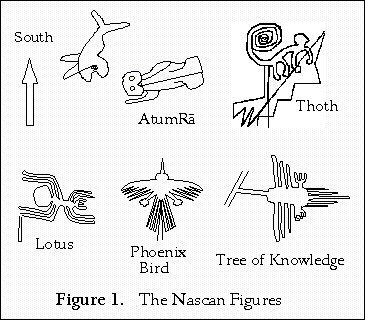
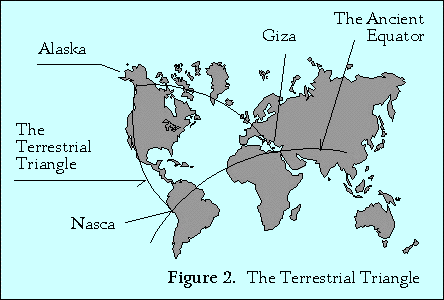
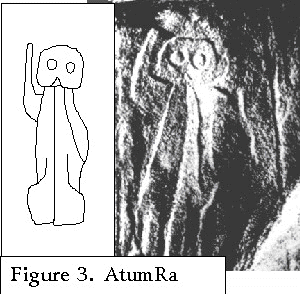
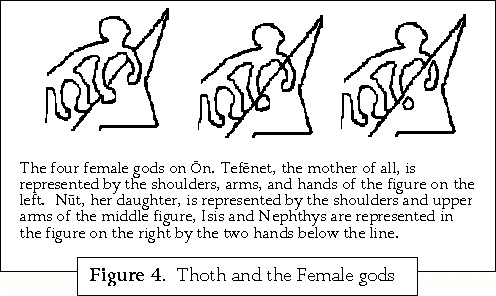
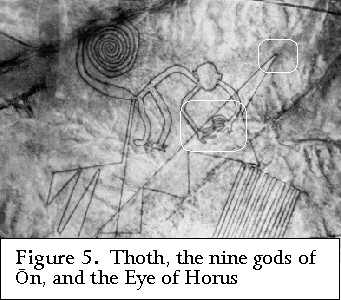
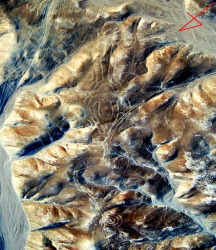 A new giant picture on the Nazca Plateau in Peru, which is famous for giant patterns that can be seen from the air, has been discovered by a team of Japanese researchers.
A new giant picture on the Nazca Plateau in Peru, which is famous for giant patterns that can be seen from the air, has been discovered by a team of Japanese researchers.